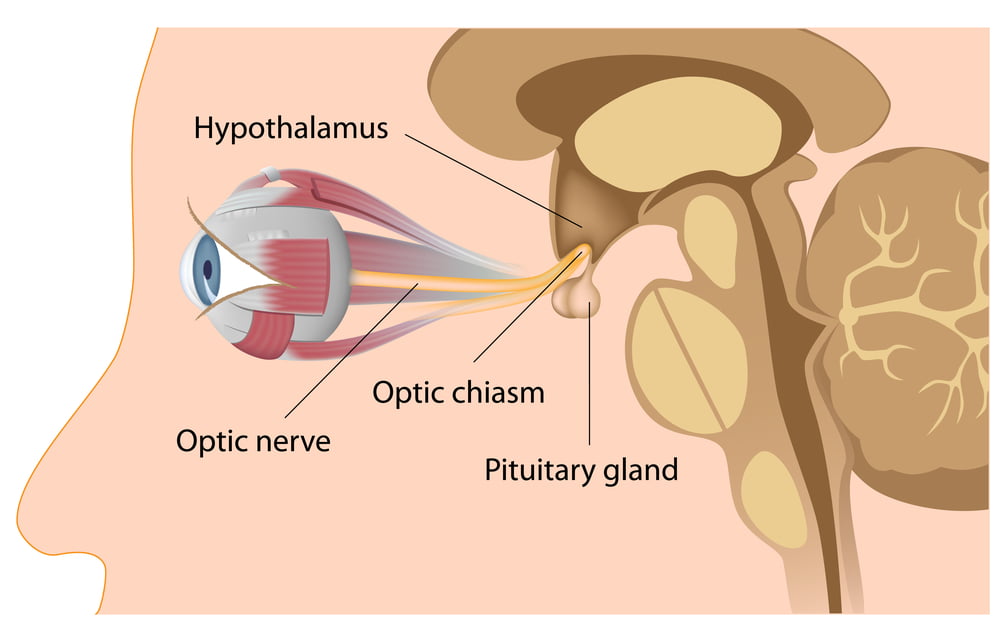Resection of pituitary tumors in Türkiye
Hypopituitarectomy is the surgical removal of the pituitary gland with the aim of treating cancerous or benign tumors. This small gland (the size of a pea) is located in the brain behind the eyes and is responsible for the secretion of a number of hormones that regulate many activities in the body, including body growth, metabolism and sexual reproduction.

Reasons to remove pituitary tumors, including:
- Removal of tumors around the pituitary gland.
- Excision of craniopharyngeal tumors (craniopharyngeal tumors) and tumors from the histology around the gland.
- Treating Cushing’s syndrome, which occurs when your body is exposed to too much cortisol.
- Improving vision by removing excess tissue or masses from around the gland.
- Only part of the pituitary gland may be removed during surgery.
What are the different types of this procedure?
There are several types of pituitaryctomy:
- Transsphenoidal endoscopic approach: The pituitary gland is brought out through the nose through the opening of the sphenoid sinus, a cavity near the back of the nose through a surgical microscope or endoscopic camera.
- Craniotomy: The pituitary gland is removed by lifting it from under the frontal part of the brain through a small opening in the skull.
- Stereotactic radiosurgery: We place a surgical helmet with specific tools and then destroy the pituitary gland and the tumors or surrounding tissues, using radiation to remove specific tissues while preserving the healthy tissues around them, but this procedure is used in the form of small tumors.
Excision of pituitary tumors:
Before the procedure:
- Take a few days off from work or other normal activities.
- Asking someone to accompany the patient home after recovering from the procedure.
- Schedule imaging tests to see the tissue surrounding the pituitary gland.
- Ask your surgeon about the type of pituitaryctomy that is right for you.
- Sign the medical consent form, which outlines all of the possible risks involved in the procedure.
- Undergoing blood tests, a chest X-ray, or an electrocardiogram (ECG) to make sure the anesthesia is safe.
Action
The operation takes place in the hospital and the patient is placed in a coma through general anesthesia, but with regard to the steps of the procedure, they differ according to the method chosen by the specialists that suits the patient’s condition, but we will discuss the most famous method, which is the transsphenoidal approach.
First, the patient is placed in a semi-recumbent position with their head fixed. Several small incisions are made under the upper lip and through the sinus cavity. An endoscope is inserted to keep the nasal cavity open and another endoscope is inserted to display images of the nasal cavity on a screen. Special surgical instruments, such as Rangers forceps, are used to remove the tumor and part or all of the pituitary gland. Fat, bone, cartilage, and some surgical materials are then used to rebuild the area from which the tumor and gland were removed. Finally, gauze treated with antibacterial ointment is placed in the nose to prevent bleeding and infections. The wounds in the sinus cavity and on the upper lip are sutured with stitches.
after the procedure
Pituitary resection can take up to two hours, then the affected person spends another two hours in the recovery ward before returning to the neurosurgical ward. Most patients go home the next day, but before that they make a follow-up appointment with a neurosurgeon and an endocrinologist (a doctor who specializes in Hormonal disorders) 6-8 weeks after surgery and blood tests, eye examinations and head examination are performed. Some people need hormone replacement therapy after surgery, such as cortisol (a steroid that helps the body deal with stress). The drug most commonly used to replace cortisol is called hydrocortisone.
Possible complications of pituitary tumor resection
- Cerebrospinal fluid leak: This is a rare complication that occurs when cerebrospinal fluid (CSF) leaks from the brain and spine into the nervous system. CSF is a clear liquid that protects and cushions the brain and spine. If you have a CSF leak, you may experience headache, neck stiffness, nausea, vomiting, and fever. CSF leaks can usually be treated with a lumbar puncture, which is a procedure to remove excess fluid from the spine. However, in some cases, surgery may be necessary.
- Pituitary insufficiency: This is a condition that occurs when the pituitary gland does not produce enough hormones. The pituitary gland is a small gland located at the base of the brain. It produces hormones that control many important bodily functions, including growth, metabolism, and reproduction. If you have pituitary insufficiency, you may experience fatigue, weakness, weight gain, sensitivity to cold, and changes in mood. Pituitary insufficiency can usually be treated with hormone replacement therapy.
- Diabetes insipidus: This is a condition that occurs when the body does not properly control the amount of water in it. This can lead to excessive thirst and urination. Diabetes insipidus can usually be treated with medication.
A medical review is required if:
- frequent nosebleeds.
- Feeling very thirsty.
- vision loss.
- Clear liquid coming out of your nose.
- Salty taste in the back of your mouth.
- urinating more than usual.
- Headache that does not go away with pain relievers.
- a rise in temperature.
- Constant drowsiness or tiredness after surgery.
- Frequent vomiting or diarrhea.
Resection of pituitary tumors in Türkiye
The medical staff of surgical teams, doctors, and consultants at REHABTÜRK can provide the best treatment options and free consultations. We strive to keep abreast of the latest medical technologies and methods to provide our patients with the highest quality care.

